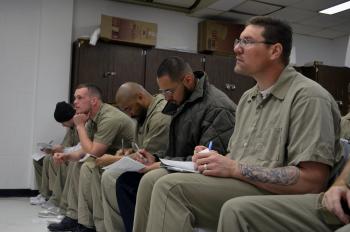Reentry plays critical role in NDCS mission to keep people safe
Reentry plays critical role in NDCS mission to keep people safe
“As soon as they get here, they should be thinking about a plan,” said Reentry Specialist Tony Britten. “We’re here to help the population develop those plans. It’s never too early to start thinking about your future.”
The reentry team with the Nebraska Department of Correctional Services (NDCS) is helping incarcerated individuals prepare for their return to the community and providing opportunities for skill development during incarceration, both of which will help them realize a brighter future.
The team, comprised of nine reentry specialists in addition to supervisors, wastes little time. Reentry starts at intake to either the Diagnostic and Evaluation Center (DEC), Nebraska Correctional Center for Women (NCCW) or Nebraska Correctional Youth Facility (NCYF). The reentry team’s goal is to see every person at a reentry orientation meeting within their first few weeks of entering the system.
Orientation meetings serve as an introduction to the reentry process, with information on how to prepare for parole, Post-Release Supervision (PRS) or discharge. After orientation, meetings get more in-depth and tailored toward each individual’s needs. Parolees meet with specialists about halfway through their sentence, while individuals in restrictive housing meet when they are within 157 days of their scheduled release. Anyone leaving NDCS, regardless of their route to release, will also meet with specialists 120 days prior to release. Individuals discharging without PRS meet once more 30 days prior to their release.
“There is a tremendous amount of reentry assistance available within NDCS’ system,” said Reentry Program Manager Steve Fannon. “We hope every person leaving our care leaves with the peace of mind that their needs are covered.”
Incarcerated individuals work through reentry workbooks that help identify needs in key areas of reentry including housing, transportation, employment/education, medical/medication, mental health/addiction recovery, identification, leisure activities and an immediate plan for the first 24 hours after release. When necessary, they complete a parole preparation form and read parole handbooks and booklets with more specific details about resources on the outside. Specialists work with individuals to develop a comprehensive plan which identifies both goals for success and barriers that may come into play.
“I learned that they can help you with owning your own home and help you with education when you get out,” one incarcerated individual at the Nebraska State Penitentiary (NSP) said. “It gives me different avenues I can take to better succeed in the community.”
During one reentry meeting at NSP, incarcerated men asked a variety of questions, ranging from “how much will my driver’s license cost?” to “how soon will parole officers do a house check before I parole?”
Reentry Specialist Stena Beltz-Seamann urged the population to begin perusing employment opportunities prior to their parole or discharge dates. They can do this by making daily to-do lists, gathering references’ contact information, networking and continually updating their resumes. She also told the class they will need to discuss their felony charges during job interviews.
“Be prepared to talk about the skills you’ve gained while you were in here,” Beltz-Seamann told the group. “Those are things that you can use to your advantage.”
The importance of networking during incarceration is also fundamental for successful reentry. Networking opportunities are available with parole officers and NDCS’ six Vocational and Life Skills (VLS) partners – ReConnect, Inc; the Center for People in Need; Metropolitan Community College; the Mental Health Association of Nebraska; Bristol Station and Associated Builders and Contractors. These organizations provide assistance with education, employment readiness, hands-on job skills, transitional housing, mental health and substance abuse support and many other areas of reentry.
Many of these VLS organizations employ formerly incarcerated individuals. They know what incarcerated individuals are going through because they’ve been there themselves.
“They’ve walked in your shoes,” Beltz-Seamann said. “It’ll be someone who can really help you.”
All of the services that these VLS partners offer are available free of cost both during incarceration and for 18 months after release.
“I found out there are a lot more options out there,” one incarcerated individual at NSP said of the reentry process. “It gave me hope that there are people out there who care.”
One incarcerated individual is currently serving his second sentence within NDCS. The 24-year-old said he has been in and out of prisons throughout the country for 15 years, and is now at the Lincoln Correctional Center (LCC). During his reentry meeting, he acknowledged that he doesn’t want to come back to prison, but is concerned with falling back into old criminal habits, alcohol and drugs.
After an in-depth conversation with a reentry specialist, the individual said, “I always looked at it like time’s running out, but not anymore. I don’t think it’s too late. It’s comforting to know that you guys are here to help.”
Some individuals request one-on-one reentry meetings to discuss topics specific to their reentry. One individual at LCC, for example, scheduled a meeting with Reentry Specialist Rob Kocks to discuss his substance abuse treatment plans prior to his parole board hearing in April.
“I wouldn’t have been able to find treatment placement if it weren’t for Rob,” this individual said. “He helped get me in contact with treatment centers by making phone calls on my behalf.”
Learning moments may come from time spent with incarcerated peers, NDCS team members, volunteers and VLS partners. Everyone plays a role and everyone has influence.
“The more that we are able to better equip these individuals for their reentry, the more we are able to lower the recidivism rate as well as the victim rate in our communities,” Kocks said. “It’s all about making our state a safer place to live.”




